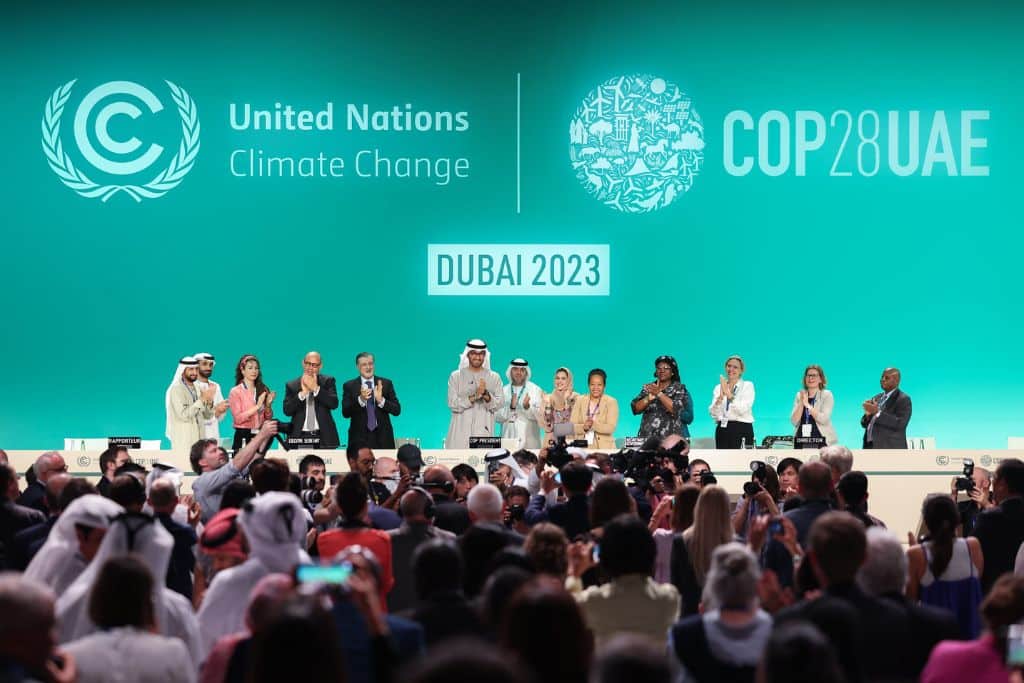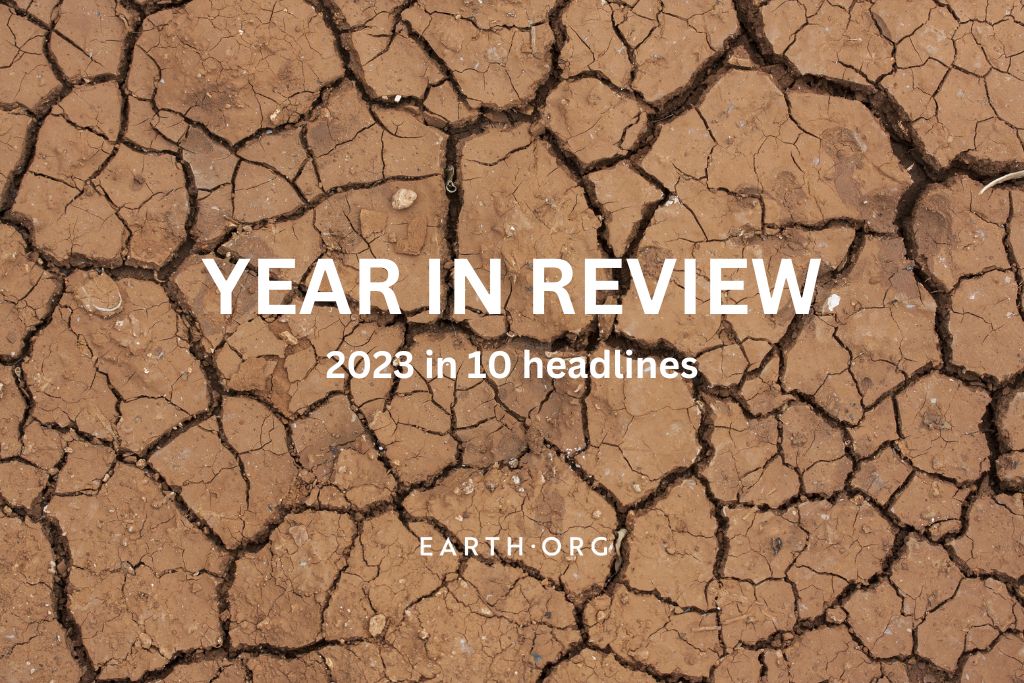As we bid farewell to 2023, Earth.Org takes a look back at the most significant climate news and events that shaped the year. From historic climate summits to alarming environmental reports, join us as we recap the top climate headlines that made waves in 2023.
—
Biggest Climate Headlines of 2023
1. 2023 to Be Hottest Year Ever Recorded at 1.4C Above Pre-Industrial Levels
The world is set to bid farewell to a “remarkable” year that will go down in history as the hottest on record, with global average temperatures at 1.46C above pre-industrial levels and 0.13C higher than the eleven-month average for 2016, currently the warmest calendar year on record.
It follows the hottest summer on record, with July remaining the warmest month in history. Throughout that month, more than 6.5 billion people – approximately 81% of the global population – faced climate change-attributed heat, a recent analysis found. The average global temperature between June and August was 16.77C (62.18F), 0.66C above the 1990-2020 average. In Europe – the world’s fastest-warming continent, warming twice as fast as any other continent – temperatures were 0.83C above average at around 19.63C (67.33F).
“2023 has now had six record breaking months and two record breaking seasons. The extraordinary global November temperatures, including two days warmer than 2ºC above preindustrial, mean that 2023 is the warmest year in recorded history,” said EU Climate Change Copernicus Service (C3S) Deputy Director Samantha Burgess.
Read more here.
2. COP28 Deal Makes Unprecedented Call to ‘Transition Away’ From Fossil Fuels

The highly controversial UN climate summit (COP28) ended with a deal that saw countries commit to moving away from fossil fuels for the first time in history. The final agreement calls on countries to “transition away from fossil fuels in energy systems, in a just, orderly and equitable manner to achieve net-zero by 2050 in keeping with the science.”
While falling short of the key “phase out” of fossil fuels that 120 countries, including the European Union, called for, the final agreement does break new ground. It is the first time a COP text mentions moving away from planet-warming oil and natural gas, fuels that have underpinned the global economic development for nearly a century.
Read more here.
You might also like: Did COP28 Succeed or Fail?
3. Record Ocean Temperatures Push World Climate and Marine Life Into Risk Zone
Extreme temperatures this year did not only affect people around the world but also marine ecosystems, as sea and ocean temperatures reached their warmest surface temperatures on record. August as a whole saw the highest global monthly average sea surface temperatures ever recorded across all months, while daily temperature records were broken every day from July 31 to August 31. In places like Florida, ocean temperatures surpassed the 38C (100F) mark, adding to previous warnings over warming water putting marine life and ecosystems in peril. Meanwhile, the Mediterranean Sea’s surface temperature hit 28.7C (83.7F), the highest median recording since at least 1982.
According to an EU-backed study published in October, the rapid rise in ocean temperatures and water levels due to anthropogenic climate change is having far-reaching consequences on marine life and global weather systems. The nearly 100 scientific experts who worked on the report were able to identify various “unusual” patterns across the world’s ocean systems, including changes in circulation currents, more frequent and intense marine heatwaves, and unexpected events in biological production.
Specifically, rising sea surface and subsurface temperatures can have serious implications for marine species, such as coral reefs, kelp, and fish, often resulting in mass die-offs and migrations that inevitably lead to lower catch amounts and increased pressure on the fishing industry. They can also impact the salinity and freshwater levels in the oceans, altering oceanic circulation, currents, and water cycles, and can lead to a rise in sea levels.
Read more here.
4. UN Gives World Oceans ‘A Fighting Chance’ With Adoption of Landmark High Seas Treaty
Speaking of oceans, 193 UN member nations adopted the world’s first treaty to protect the high seas and preserve marine biodiversity in June, following nearly two decades of fierce negotiations over a common conservation strategy in the high seas beyond national boundaries.
High seas, vast stretches of water beyond national boundaries that cover two-thirds of all ocean and almost half of the planet, are home to up to 10 million species, and are an invaluable source of food for billions of people. Despite their importance, only 1% of high seas is currently protected, and climate change-related phenomena such as ocean acidification, as well as human activities like overfishing, pose a growing threat to the world’s oceans. Plastic pollution also represents a major issue. In 2021, plastic made up 85% of all marine litter, and if this trend continues, the UN estimated that by 2050, there could be more plastic in the sea than fish.

The High Seas Treaty addresses four major themes: Marine genetic resources, area-based management tools – including marine protected areas, environmental impact assessment, as well as capacity building and transfer of marine technology. In line with the 1982 UN Convention on the Law of the Sea (UNCLOS), the new treaty contains 75 articles aimed at “protecting, caring for, and ensuring the responsible use of marine environment, maintaining the integrity of ocean ecosystems, and conserving the inherent value of marine biological diversity.”
For this to happen, countries must first of all work towards stopping destructive trends, including marine plastic pollution and unsustainable fishing practices. This means that signatories are now legally required to assess the potential impacts of any planned activities beyond their national jurisdiction.
Read more here.
5. World ‘More Likely Than Not’ to Breach 1.5C Temperature Limit by 2027, UN Warns
A United Nations’ report published in May warned that there is a 66% chance that the world will breach the critical 1.5C global warming threshold in the next four years, owing to a rise in anthropogenic carbon emissions and the El Niño weather pattern.
The World Meteorological Organization (WMO) also suggested a 98% chance of at least one year between now and 2027 exceeding history’s warmest year on record, 2016, which happened after an “exceptionally strong” El Niño event. Indeed, the El Niño Southern Oscillation expected between December and February next year – a phenomenon that pushes more heat up from the oceans into the atmosphere – will push global temperatures off the charts, resulting in unprecedented heatwaves.
Read more here.
6. Climate Change Made This Summer’s Floods in the Mediterranean Up to 50 Times More Likely, Scientists Say
A study by the World Weather Attribution found a clear link between climate change and this summer’s extreme rainfall events in the Mediterranean region, including Greece, Turkey, and Libya. The authors note that increased greenhouse gas emissions have intensified the hydrological cycle, leading to more frequent and intense rainfall events. These extreme downpours, coupled with factors such as population density, urbanisation, and inadequate infrastructure, have resulted in significant impacts on communities, ecosystems, and the economy.

Greece’s flooding in early September, which researchers say is a 1-in-250-year event, was made up to 10 times more likely to occur and 40% more intense by anthropogenic climate change. As for Libya’s floods, a catastrophic natural events that typically occurs once every 300 to 600 years, researchers found that climate change made it up to 50 times more likely and up to 50% more intense compared to a 1.2C cooler climate.
Read more here.
7. Antarctica Lost 7.5tn Tonnes of Ice Since 1997
More than 40% of Antarctica’s ice shelves have been steadily shrinking since 1997, with almost half of them showing no sign of recovery, researchers at the University of Leeds have found.
The team of scientists behind the study embarked on a daring mission to explore the dynamics of Antarctica’s ice shelves. What they uncovered is nothing short of alarming: from 1997 to 2021, the continent lost a staggering 7.5 trillion metric tonnes of ice. While the eastern part of Antarctica experienced a gain of 59 trillion tonnes, the western region suffered a catastrophic loss of 67 trillion tonnes.
The loss of 67 trillion metric tonnes of freshwater into the ocean over a span of 25 years has significant implications for global climate patterns. Ocean currents serve as the conveyor belts of heat and nutrients, and any disruption can have a profound impact on weather patterns, fisheries, and ecosystems worldwide. Antarctica’s plight is not confined to its icy borders; its fate is intertwined with the fate of the entire planet.
In other Antarctica news, recent research has also suggested that climate change-triggered melting of sea ice in Antarctica is taking a heavy toll on emperor penguins and could wipe out over 90% of the species colonies by 2100.
Read more here.
8. Devastating Maui Wildfires Kill 100 People in One of Deadliest Wildfire in US History

In early August, a devastating wildfire wreaked havoc on the west coast of the Hawaiian island of Maui, killing 100 people and prompting the evacuation of thousands of residents and tourists. Fuelled by unusual weather conditions including low humidity and strong winds from distant hurricane Dora, flames engulfed the historic town of Lahaina – Maui’s largest tourist destination, destroying much of its homes, businesses, and the harbour.
Although Maui generally enjoys wet and rainy weather conditions, climate change is having a negative impact on how often rainfall occurs, triggering rare drought conditions and water shortages. Over the last three decades, rainfall in Hawaii has decreased by 18%.
US President Joe Biden issued a major disaster declaration as evacuation centres across the island filled following one of the nation’s deadliest fires in decades.
Read more here.
9. Up to 500,000 Indigenous People Could Be Affected by Historic Amazon River Drought
Extreme temperatures in 2023 have dried up Amazon River waterways on which Indigenous communities depend, leaving them stranded without fuel, food, and drinking water.
Parts of the Amazon River, the largest river by volume and the second-longest in the world, currently in its dry season, have been drying up at a rate of 30 centimetres (11.8in) per day since mid-September as a result of record-high temperatures and unusual dryness in the region. By the end of September, the river stood at 16.4 metres (54 feet), about six metres below its level in the same period last year, leaving entire communities stranded and struggling to access vital resources including fuel, food, and fresh water.
The drought is currently affecting forty-two of the 62 municipalities, home to more than 300,000 people, though state authorities warned that up to 500,000 people might be affected over the next several weeks amid predictions of prolonged low precipitation that could last until early 2024, making the current drought the worst the state has ever experienced.
“We have never seen anything like this. It is the worst drought in history,” said Amazonas governor Wilson Lima.
Read more here.
10. China On Track to Meet Clean Energy Target Five Years Ahead of Schedule
As countries at COP28 agreed to triple renewable energy capacity by 2030, China stood out as the global leader in the sector. According to the non-profit Global Energy Monitor’s (GEM) annual report on utility-scale solar and wind power facilities, the rapid renewable energy deployment across China over the past 15 years has brought the country to the top of the global wind and solar leaderboard, putting it on track to double its wind and solar capacity by 2025 and reach its clean energy target five years ahead of schedule.
While China’s progress on renewables is unmatched, clean energy is rapidly expanding around the world. According to the International Energy Agency (IEA), the power sector is set for a “tipping point” on its carbon dioxide emissions, as renewables and other cleaner sources – including nuclear energy – are on track to cover most of the new global electricity demand by 2025.
Read more here.

















